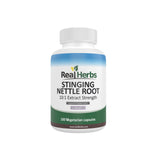Stinging Nettle Root and Women's Reproductive Health: Insights and Considerations
Introduction
In the realm of natural remedies, stinging nettle root has emerged as a subject of growing interest, with its historical roots firmly planted in traditional medicine. Widely recognized for its unique properties, this botanical wonder has found its way into contemporary health discussions, sparking curiosity about its potential benefits. Among the various aspects of well-being it may influence, women's reproductive health stands out as a focal point. In this article, we delve into the intricacies of stinging nettle root, exploring its nutritional components, historical significance, and the evolving body of research suggesting its potential impact on women's reproductive health.
Background on Stinging Nettle Root
Stinging nettle (Urtica dioica) is a perennial flowering plant that has played a role in herbal medicine for centuries. Its serrated leaves, armed with tiny hairs that release stinging chemicals upon contact, have been both revered and cautiously approached. Beyond its stinging exterior, the root of the nettle plant holds a trove of nutrients, including vitamins, minerals, and bioactive compounds.
Used in various cultures for ailments ranging from joint pain to allergies, stinging nettle has garnered attention for its potential health benefits. Traditional applications include its use as a diuretic, an anti-inflammatory agent, and a remedy for seasonal allergies. As we turn our focus to women's reproductive health, it becomes imperative to explore the specific elements within stinging nettle root that may contribute to its purported positive effects.
Nutritional Components
Stinging nettle root boasts a rich nutritional profile, containing essential vitamins such as A, C, and K, as well as minerals like iron, magnesium, and calcium. The presence of bioactive compounds, including flavonoids and polyphenols, adds to its potential therapeutic value. Understanding these nutritional components lays the foundation for comprehending how stinging nettle root may influence women's reproductive health.
Potential Benefits for Women's Reproductive Health
The exploration of stinging nettle root's impact on women's reproductive health unveils a spectrum of potential benefits. Emerging studies suggest that certain compounds within the root may interact with hormonal pathways, influencing menstrual cycles and hormonal balance. While research is ongoing, there is growing interest in the use of stinging nettle root as a natural remedy for conditions like premenstrual syndrome (PMS) and menstrual irregularities.
One notable component is lignans, known for their phytoestrogenic properties. These compounds may mimic the action of estrogen in the body, contributing to the regulation of hormonal fluctuations. As estrogen levels play a pivotal role in the menstrual cycle, stinging nettle root's potential to modulate these levels could offer support for women experiencing hormonal imbalances.
Additionally, the anti-inflammatory properties of stinging nettle root may provide relief from conditions like endometriosis, a disorder where tissue similar to the lining of the uterus grows outside the uterus, often causing pain and fertility issues. While more rigorous research is needed, preliminary findings suggest that the anti-inflammatory effects of stinging nettle root could potentially alleviate some symptoms associated with reproductive disorders.
Considerations and Precautions
Before incorporating stinging nettle root into one's routine, it's crucial to consider potential side effects and interactions. While generally regarded as safe when used appropriately, stinging nettle may cause mild gastrointestinal discomfort or allergic reactions in some individuals. Those with a history of allergies to plants in the Urticaceae family should exercise caution.
Pregnant and breastfeeding women should consult with healthcare professionals before using stinging nettle products. The effects of stinging nettle on pregnancy are not yet fully understood, and it's essential to prioritize the safety of both the mother and the developing fetus.
As with any herbal supplement, moderation is key. Excessive consumption of stinging nettle root may lead to adverse effects, emphasizing the importance of adhering to recommended dosages and guidelines.
Dosage and Forms
Stinging nettle root supplements are available in various forms, including capsules, tinctures, and teas. Determining the appropriate form and dosage depends on individual preferences and health needs. Consulting with a healthcare provider can help tailor the usage to specific health goals, ensuring a personalized and effective approach.
When selecting a stinging nettle product, opt for reputable brands that adhere to quality standards. Ensuring the product is sourced from trusted suppliers minimizes the risk of contaminants and ensures a potent and safe supplement.
Conclusion
In this exploration of stinging nettle root and women's reproductive health, we've traversed the historical applications, nutritional components, and potential benefits of this botanical remedy. While promising, it's essential to approach stinging nettle root with a discerning eye, considering individual health circumstances and seeking professional guidance.
As research continues to unfold, stinging nettle root remains a fascinating subject within the realm of natural health. For women navigating reproductive health challenges, the integration of stinging nettle root warrants consideration but should always be approached with a well-informed and cautious mindset. As with any health-related decision, consulting with healthcare professionals ensures a holistic and personalized approach to well-being.












